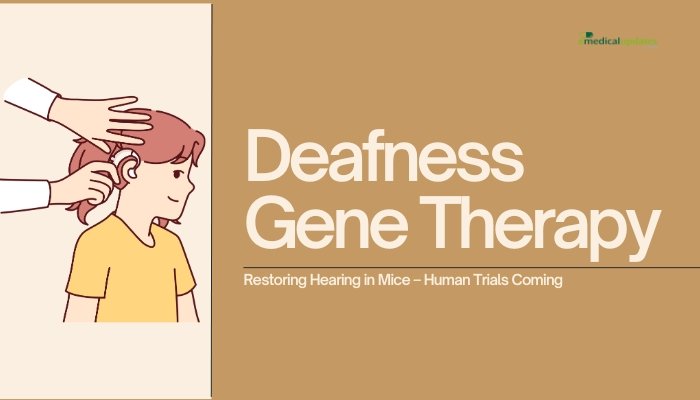Introduction
From congenital deafness to noise-induced hearing loss, hearing impairment affects millions worldwide. Conventional aids, like hearing aids or cochlear implants, improve sound detection but can’t fully restore normal hearing.
Now, gene therapy promises a more direct route by tackling the root genetic or cellular defects. Recent studies demonstrate successful hearing restoration in mice using targeted gene editing or viral vectors—opening the door to eventual human trials. This article explores how these breakthroughs work, the latest evidence, and when we might see such treatments become available to people with deafness.
Why Gene Therapy for Deafness?
Limitations of Existing Solutions
- Hearing Aids: Amplify sound but rely on remaining hair cells. In profound deafness, or if hair cells are severely damaged, aids provide limited benefits.
- Cochlear Implants: Effective for many but require invasive surgery and can produce less natural sound quality.
- No Causal Fix: These devices don’t correct the underlying biological or genetic anomalies causing hearing loss.
Targeting Genetic Causes
Up to half of congenital hearing loss cases have a known genetic basis—mutations in genes like GJB2, OTOF, or STRC. Gene therapy aims to:
- Deliver Functional Genes: Using viruses or other vectors to replace or supplement faulty ones.
- Repair Genes via Editing: Using CRISPR-Cas9 or related systems to correct disease-causing mutations in cochlear sensory cells.
Breakthrough in Mouse Models
The Experiment
Researchers genetically engineered mice with a deafness mutation. By injecting a harmless viral vector carrying a corrected version of the mutated gene into the inner ear:
- Expression of Healthy Protein: The delivered gene produced normal functional proteins in cochlear hair cells.
- Auditory Threshold Improvement: Post-treatment, mice regained partial or significant hearing, measured via brainstem auditory response tests.
Notable Results
- Sustained Effect: Some mice maintained improved hearing for months, suggesting long-term gene expression.
- Minimal Harm: No major inflammatory or toxic responses were reported, indicating potential safety of the procedure.
Approaches to Gene Therapy for Hearing
Viral Vectors (AAV, Adenovirus)
Adeno-associated viruses (AAV) are common, as they:
- Efficiently Infect Cochlear Cells: AAV can enter hair cells in the inner ear.
- Low Immunogenicity: Typically produce mild or no inflammatory reaction.
- Stable Expression: Potential for long-lasting gene production after a single injection.
CRISPR and Gene Editing
For certain single-gene mutations:
- CRISPR-Cas9 can directly correct the defective gene in situ, providing a more permanent fix.
- Challenges: Achieving high editing efficiency in delicate cochlear tissue, ensuring no off-target cuts.
Non-Viral Methods
Researchers explore lipid nanoparticles, gene delivery peptides, or other advanced carriers to reduce dependence on viruses. While promising, most efforts remain in preclinical or early-phase labs.
Path Toward Human Trials
Safety First
Sensory hair cells in the cochlea are finite and fragile. Damaging them can exacerbate hearing loss. Trials must demonstrate the gene therapy is safe for precious inner ear structures:
- Targeted Delivery: Minimizing escape of the vector to other organs.
- Controlled Dosage: Enough to drive meaningful gene expression without toxicity.
Efficacy Thresholds
To justify a gene therapy, results must surpass existing hearing solutions in clarity, range, or functional improvement. Standardized hearing tests in human participants will measure improvements in real-life auditory tasks.
Regulatory and Ethical Factors
- Informed Consent: Deafness may be part of a cultural identity. Some in the Deaf community have concerns about “fixing” hearing.
- Cost and Access: Advanced gene therapies can be expensive. Insurance coverage and distribution models remain uncertain.
Potential Benefits Over Current Options
- Restoring Natural Hearing: Instead of mechanical amplification, gene therapy aims to reestablish normal hair cell function.
- Single Intervention: Potentially a one-time procedure with lasting impact, reducing lifetime device maintenance.
- Early Intervention: If proven safe, newborns identified via hearing screening might receive therapy to prevent speech development delays.
Challenges and Limitations
Variation in Deafness Etiologies
Thousands of genetic variants can cause hearing loss. A therapy targeting one gene may not help other forms. Custom or multi-gene approaches are needed for diverse patients.
Potential Immune Response
Even “low immunogenic” vectors could trigger immune reactions, particularly if repeated administrations are needed. Overcoming immune barriers is vital for safety.
Real-World Efficacy
Mice differ from humans anatomically and genetically. Gains in rodent hearing can’t guarantee parallel success in humans, demanding robust clinical trials.
Frequently Asked Questions
- How soon might this therapy be available?
- Timelines remain uncertain. Early-phase human trials may commence in the next few years, with broader availability possibly a decade away.
- Is all deafness genetic?
- Not all. Many cases are, but environmental factors like infections or trauma also cause hearing loss. Gene therapy may not help non-genetic deafness.
- Will gene therapy restore full normal hearing?
- Possibly partial or near-normal hearing if the therapy effectively regenerates or repairs hair cells. Final results differ by individual and type of mutation.
- Does one therapy address all hearing gene mutations?
- Typically not. Therapies often target specific, common mutations. Broader solutions or personalized treatments might come later.
- Is CRISPR the main approach?
- CRISPR is one possibility. Many labs still use viral gene replacement. The approach depends on the mutation, safety profile, and efficiency required.
Conclusion
Gene therapy for deafness—with pivotal success shown in mouse studies—offers a tantalizing vision: reversing or preventing hearing loss by fixing genetic roots. If trials confirm safety and efficacy, it could transform how we treat congenital or inherited hearing impairments, surpassing mechanical aids’ limitations. Yet hurdles remain, from refining vector delivery to addressing the genetic diversity underlying deafness. While widespread human application may lie years away, this line of research signals a potential leap from supportive technologies to genuine hearing restoration—redefining possibilities for millions worldwide with hearing loss.
References
-
- Yeh E, et al. (2021). “AAV-based gene therapy for hereditary hearing loss in mouse models.” Mol Ther Methods Clin Dev.
-
- Gao X, et al. (2020). “CRISPR/Cas9 application in restoring cochlear hair cells.” Nat Commun.
-
- WHO (2023). “World Hearing Report: global hearing loss data and interventions.”
-
- Liu XZ, et al. (2019). “Genetic basis of nonsyndromic hearing loss.” JAMA Otolaryngol Head Neck Surg.





